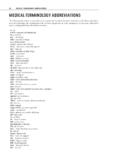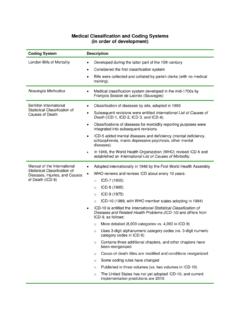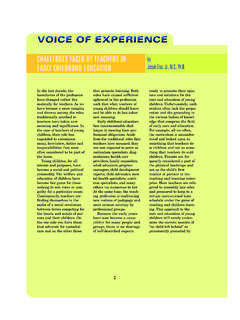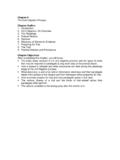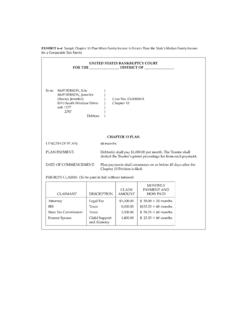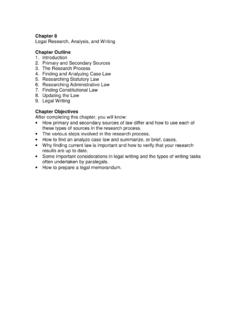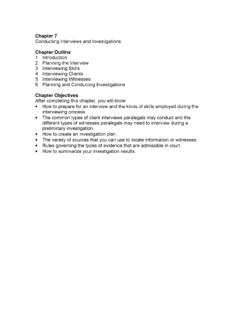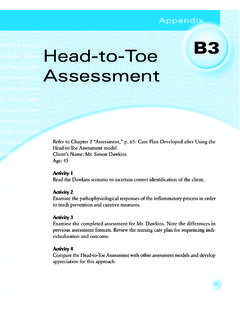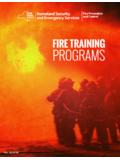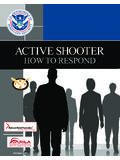Transcription of Scene Assessment and Personal Safety David Reeves, BS, …
1 Scene Assessment and Personal Safety David Reeves, BS, EMT-P. INTRODUCTION. The emergency Scene is a very dynamic environment, requiring emergency personnel to react rapidly and adapt to changing situations. Patients' injuries may be complicated by their physical position and location, and medical care is often difficult to render in the uncontrolled environment. Many external factors, such as climate, Scene hazards, and additional resources required can dictate immediate actions. Specific knowledge and resources must be obtained to meet the particular demands of the environment.
2 DISPATCH INFORMATION. Much insight can be gained into the nature of a call upon initial dispatch. Information obtained for a highway accident, such as the type of vehicle and number of patients, can indicate the resources needed to handle an incident. Certainly rescuers will think very differently about a collision involving a school bus as opposed to an accident involving a single motorcycle. Proper call screening will match the response to the type of emergency in order to increase the Safety of personnel, such as dispatching law enforcement with EMS to violent scenes.
3 Obtaining useful call information depends on the presence of trained emergency telecommunicators (TCs). Telecommunicator competency can affect the survival of the patient as well as the Safety of the emergency personnel. Many states have established guidelines for telecommunicator performance, strengthening their role as a valuable link in the chain of survival. -1. Scene SIZE-UP. "Size-up" is the initial quick analysis of the Scene upon arrival. The Scene size-up is vital to safe and efficient operations. A rapid and accurate evaluation is required, especially when hazards are present.
4 This provides for the Safety of the emergency crew and validates the information provided during dispatch for other arriving rescuers. There are several key items to look for when approaching the Scene . Any immediate hazards, such as fuel, downed power lines, or a person with a weapon should be noted. These hazards should be mitigated prior to operating at the Scene . Next, the mechanism of injury or illness should be noted. Mechanism of injury refers to how the injury occurred, such as a broken windshield associated with a laceration to the head. If time allows, take a quick look at the actual site of the incident.
5 Remember that patients are frequently moved from the accident area. Viewing the area where the injury actually occurred may provide valuable insight into the patient's injuries. Calculate the total number of patients and the types of injuries. Both will dictate the number and type of ambulances needed and any specialty resources required, such as hazardous materials (hazmat) teams or utility companies. Remember that the emergency Scene is dynamic; a Safety officer who constantly observes for hazards as the Scene changes will ensure continued Scene Safety .
6 Observing the environment during response provides information about the Scene prior to arrival. The simple fact that traffic lights are not operating or lights are off in stores may be a good indication of downed power lines. A lack of oncoming traffic while en route to a motor vehicle crash (MVC) Scene may indicate that the road is blocked. -2. Once on the Scene , take a few seconds to look around. Is the Scene consistent with the dispatch information? Looking into a window as you approach a patient's home may allow observation of activity in the home without alerting those inside to your presence.
7 When knocking on a door, stand to one side, away from view as the door is opened. This places you out of the blast zone if someone shoots through the door, and prevents people from easily viewing your position if the door is cracked open. Be observant of the overall Scene . Is the front door kicked in? A telephone torn from the wall is usually done to prevent someone from calling for help. Hazardous Materials A hazardous material is any substance that poses an unreasonable risk to health and/or Safety . Four billion tons of hazardous materials are carried by surface, air, rail, and water annually.
8 The Superfund Amendments and Reauthorization Act of 1986 (SARA), the Environmental Protection Agency (EPA), and the Occupational Safety and Health Administration (OSHA) have demanded greater responsibility for incidents involving hazardous materials. These demands have set the stage for standardized hazardous materials training across the United States. Hazardous materials are indiscriminate in causing harm. Protection of emergency personnel is vital to the successful mitigation of the hazard. Due to the common use of chemicals in today's society, virtually any incident may involve hazardous materials.
9 These scenes may require eye, ear, skin, and respiratory protection, as well as special techniques to identify the involved substances. Specialized protection requires training in the use of the protective equipment. Identification of hazardous substances is a priority because this knowledge dictates -3. what actions are appropriate. Do not overlook an on-site supervisor or Safety team member who may be a valuable resource. NFPA 473 (1997) outlines competencies for EMS personnel who respond to hazardous materials (hazmat) incidents as part of their duties.
10 Hazmat training for the EMS responder is based on awareness of the potential harm that may be caused by operating blindly at an incident. Presence of mind and self-discipline are paramount in preventing complication of the situation. It is important for the paramedic to be able to recognize a hazmat incident through the use of placards, labels, shipping papers, and any other identification methods. Once the Scene has been identified as involving hazardous materials, the following agencies can provide valuable information for handling the incident: CHEMTREC (800-424-9300): A private service that provides information specific to chemicals involved in transportation accidents.
